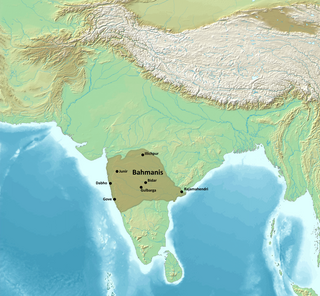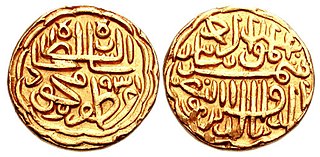
Muslim period in the Indian subcontinent is conventionally said to have started in 712, after the conquest of Sindh and Multan by the Umayyad Caliphate under the military command of Muhammad ibn al-Qasim. It began in the Indian subcontinent in the course of a gradual conquest. The perfunctory rule by the Ghaznavids in Punjab was followed by Ghurids, and Sultan Muhammad of Ghor is generally credited with laying the foundation of Muslim rule in Northern India.

The Delhi Sultanate or the Sultanate of Delhi was a late medieval empire primarily based in Delhi that stretched over large parts of the Indian subcontinent, for 320 years (1206–1526). Following the invasion of South Asia by the Ghurid dynasty, five dynasties ruled over the Delhi Sultanate sequentially: the Mamluk dynasty (1206–1290), the Khalji dynasty (1290–1320), the Tughlaq dynasty (1320–1414), the Sayyid dynasty (1414–1451), and the Lodi dynasty (1451–1526). It covered large swaths of territory in modern-day India, Pakistan, and Bangladesh as well as some parts of southern Nepal.

The Bahmani Sultanate was a late medieval Muslim empire that ruled the Deccan Plateau in South India. The Bahmani Sultanate came to power in 1347 during the Rebellion of Ismail Mukh against the Tughlaq dynasty of Delhi after Ismail Mukh abdicated in favour of Zafar Khan, who would establish the Bahmani Sultanate. The Bahmani Sultanate was in perpetual war with its neighbors, including its rival to the south, the Vijayanagara Empire.

The Lodi dynasty was a dynasty that ruled the Delhi Sultanate from 1451 to 1526. It was the fifth and final dynasty of the Delhi Sultanate, and was founded by Bahlul Khan Lodi when he replaced the Sayyid dynasty.

The Khalji or Khilji dynasty was the second dynasty which ruled the Delhi sultanate, covering large parts of the Indian subcontinent for nearly three decades between 1290 and 1320. It was founded by Jalal ud din Firuz Khalji.

Qutb-ud-Din Bahadur Shah, born Bahadur Khan was a sultan of the Muzaffarid dynasty who reigned over the Gujarat Sultanate, a late medieval kingdom in India from 1526 to 1535 and again from 1536 to 1537. He ascended to the throne after competing with his brothers. He expanded his kingdom and made expeditions to help neighbouring kingdoms. In 1532, Gujarat came under attack of the Mughal Emperor Humayun and fell. Bahadur Shah regained the kingdom in 1536 but he was killed by the Portuguese on board a ship when making a deal with them.
Muslim Rajputs or Musalman Rajpoots are the descendants of Rajputs in the northern regions of the Indian subcontinent who generally are followers of Islam. Reportedly, they converted from Hinduism to Islam from the medieval period onwards, creating various dynasties and states while retaining Hindu surnames such as Chauhan. Today, Muslim Rajputs can be found mostly in present-day Northern India and Pakistan. They are further divided into different clans.
Ahmedabad is the largest city in the state of Gujarat. It is located in western India on the banks of the River Sabarmati. The city served as political as well as economical capital of the region since its establishment. The earliest settlement can be recorded around the 12th century under Chaulukya dynasty rule. The present city was founded on 26 February 1411 and announced as the capital on 4 March 1411 by Ahmed Shah I of Gujarat Sultanate as a new capital. Under the rule of sultanate (1411–1511) the city prospered followed by decline (1511–1572) when the capital was transferred to Champaner. For next 135 years (1572–1707), the city renewed greatness under the early rulers of Mughal Empire. The city suffered due to political instability (1707–1817) under late Mughal rulers followed by joint rule between Maratha and Mughal. The city further suffered following joint Maratha rule. The city again progressed when politically stabilized when British East India Company established the rule in the city (1818–1857). The city further renewed growth when it gain political freedom by establishment of municipality and opening of railway under British crown rule (1857–1947). Following arrival of Mahatma Gandhi in 1915, the city became centre stage of Indian independence movement. Many activists like Sardar Patel served the municipality of the city before taking part in the movement. After independence, the city was a part of Bombay state. When Gujarat was carved out in 1960, it again became the capital of the state until establishment of Gandhinagar in 1965. Ahmedabad is also the cultural and economical centre of Gujarat and the seventh largest city of India.

Shams-ud-Din Muzaffar Shah II or Muzafar II, born Khalil Khan, was a Sultan of the Muzaffarid dynasty, who reigned over the Gujarat Sultanate from 1511 to 1526. He was the eldest son of Sultan Mahmud Begada and his Rajput wife, Rani Hírabai.

The Malwa Sultanate was a late medieval kingdom in the Malwa region, covering the present day Indian states of Madhya Pradesh and south-eastern Rajasthan from 1401 to 1562. It was founded by Dilawar Khan, who following Timur's invasion and the disintegration of the Delhi Sultanate, in 1401, made Malwa an independent realm.

The Gujarat Sultanate or Sultanate of Guzerat was a late medieval Indian kingdom in Western India, primarily in the present-day state of Gujarat. The kingdom was established in 1394 when Muzaffar Shah I, the Governor of Gujarat, declared independence from the Tughlaq dynasty of Delhi.

Ahmad Shah I, born Ahmad Khan, was a ruler of the Muzaffarid dynasty, who reigned over the Gujarat Sultanate from 1411 until his death in 1442. He was the grandson of Sultan Muzaffar Shah, founder of the dynasty.
The Farooqi dynasty or the Farooq Shahi was the ruling dynasty of the Khandesh Sultanate from its inception in 1382 till its annexation by the Mughal emperor Akbar in 1601. The founder of the dynasty, Malik Ahmad participated in a rebellion against the Bahmani ruler Muhmmad Shah I in his early years. When he was compelled to flee from Deccan, he established in Thalner on the Tapti River. After receiving the grant of the fiefdoms of Thalner and Karanda from Firuz Shah Tughluq in 1370, he conquered the region around Thalner, which later became known as Khandesh. By 1382, he started ruling independently.

Ala-ud-Din Hasan Bahman Shah whose original name was Zafar Khan or Hasan Gangu, was the founder of the Bahmani Sultanate.
Muhammad Shah I, born Tatar Khan, was a ruler of the Muzaffarid dynasty, who reigned over the Gujarat Sultanate briefly from 1403 to 1404 disposing his father Muzaffar Shah I.

The Khatris are desandants of the Khatri community of Indian subcontinent which embraced Islam during medieval period. They are now mostly concentrated in Pakistani provinces of Punjab, Sindh, Azad Kashmir as well as Northern India. The community is scattered throughout Punjab and Kutch region.
Malik Dinar was a native Indian slave who served as general in Khalji Dynasty of Delhi Sultanate. He served as subordinate officer Malik Kafur and was also a Shihna-yi pil or intendant of elephantry and was sent by Kafur to suppress rebellion in Gujarat. His daughter has been married the third Khalji dynasty sultan, Qutb ud din Mubarak Shah. he was given the title 'Zafar Khan'(literally chief of victory). The very same title which bestowed to one of greatest Khalji military general who repelled the Chagatai Khanate repeated invasions into India, Zafar Khan Malik Hizbaruddin.

Muzaffar Shah I, born Zafar Khan, was the founder of the Muzaffarid dynasty in Medieval India, reigning over the Gujarat Sultanate from 1391 to 1403 and again from 1404 to 1411. The Kumbalgarh inscription says that Kshetra Singh defeated and captured Zafar Khan, King of Patan and the Khan remain in imprisonment with other Rajas.
Gujarat, a region in western India, fell under Delhi Sultanate following repeated expeditions under Alauddin Khalji around the end of the 13th century. He ended the rule of Vaghela dynasty under Karna II and established Muslim rule in Gujarat. Soon the Tughluq dynasty came to power in Delhi whose emperor carried out expeditions to quell rebellion in Gujarat and established their firm control over the region by the end of the century. Following Timur's invasion of Delhi, the Delhi Sultanate weakened considerably so that the last Tughluq governor Zafar Khan declared himself independent in 1407 and formally established the Gujarat Sultanate.












